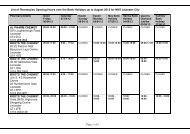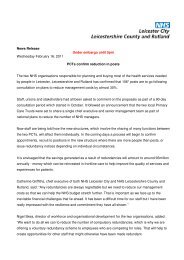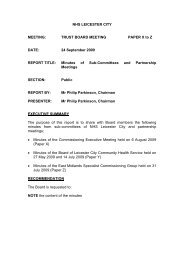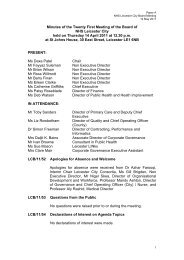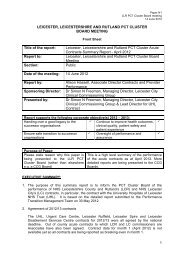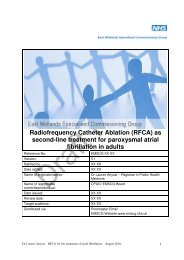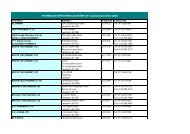POLICY FOR PATIENT GROUP DIRECTIONS (PGD) - NHS
POLICY FOR PATIENT GROUP DIRECTIONS (PGD) - NHS
POLICY FOR PATIENT GROUP DIRECTIONS (PGD) - NHS
You also want an ePaper? Increase the reach of your titles
YUMPU automatically turns print PDFs into web optimized ePapers that Google loves.
6.4.2. Is the most appropriate method of providing treatment for the group ofpatients in the defined clinical situation? (Assessment of the Clinical needfor a <strong>PGD</strong>)6.4.3. Includes the provision of Patient information leaflets (PILS) and additionalspecific information6.5. Record of consultation6.5.1. Robust recording and monitoring procedures must be in place to providea clear audit trail to allow identification of the following:6.5.1.1. Training and competency of staff skills including review (Kept by theManager of the relevant service)6.5.1.2. The health professional administering treatment.6.5.1.3. Patient treated.6.5.1.4. Treatment provided (must include batch number.)6.5.1.5. Appropriate records/ systems in place to easily identify patients andtheir notes for audit purposes6.5.1.6. Records of training / competency assessment/ sign off6.6. Risk ManagementThe following areas of risk must be considered when developing a <strong>PGD</strong>6.6.1. Chaperoning guidelines6.6.2. Consent procedures6.6.3. Complaints, Incidents and Serious Adverse Events reporting protocol (inline with PCT Incident Reporting Process)6.6.4. Significant event auditing6.6.5. Infection control and sterilisation guidelines for primary care6.6.6. Confidentiality of patient data, adherence to Caldicott principles (1999)and data Protection Act (1998)6.6.7. Research Alliance approval for research activity6.6.8. Safeguarding Children procedures and guidelines6.6.9. Safeguarding Adult procedures and guidelines7. Format of a <strong>PGD</strong>The format of the <strong>PGD</strong> must follow the template shown in appendix 1, whichcomplies with legal documents that guide practice (HSC2000/026) and corporaterequirements.8. Training requirements8.1. Clearly defined criteria for implementation, training and competencyassessment must be produced to include:8.1.1. The Law relating to <strong>PGD</strong>s8.1.2. Professional accountability and code of conduct relevant to each healthcareprofession8.1.3. Directions for use8.1.4. Differential diagnosis/patient assessment8.1.5. Dosages and frequency8.1.6. Contra-indications8.1.7. Interactions8.1.8. Side effectsPolicy for the development of Patient Group Directions (<strong>PGD</strong>)Page 10 of 23





